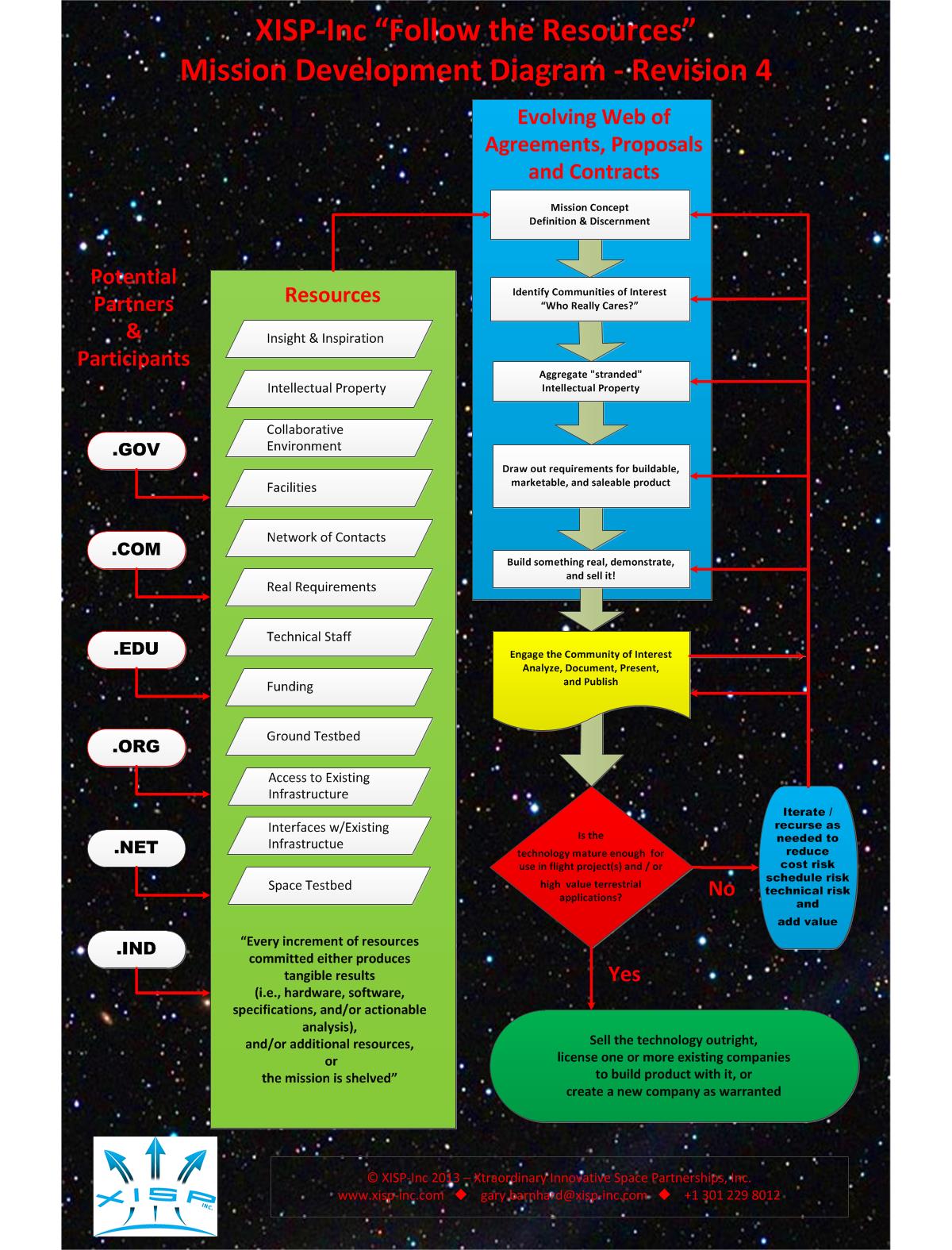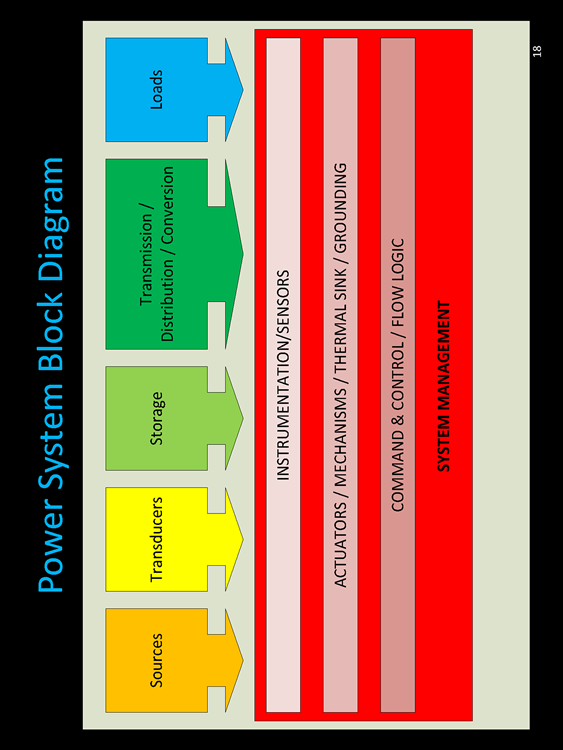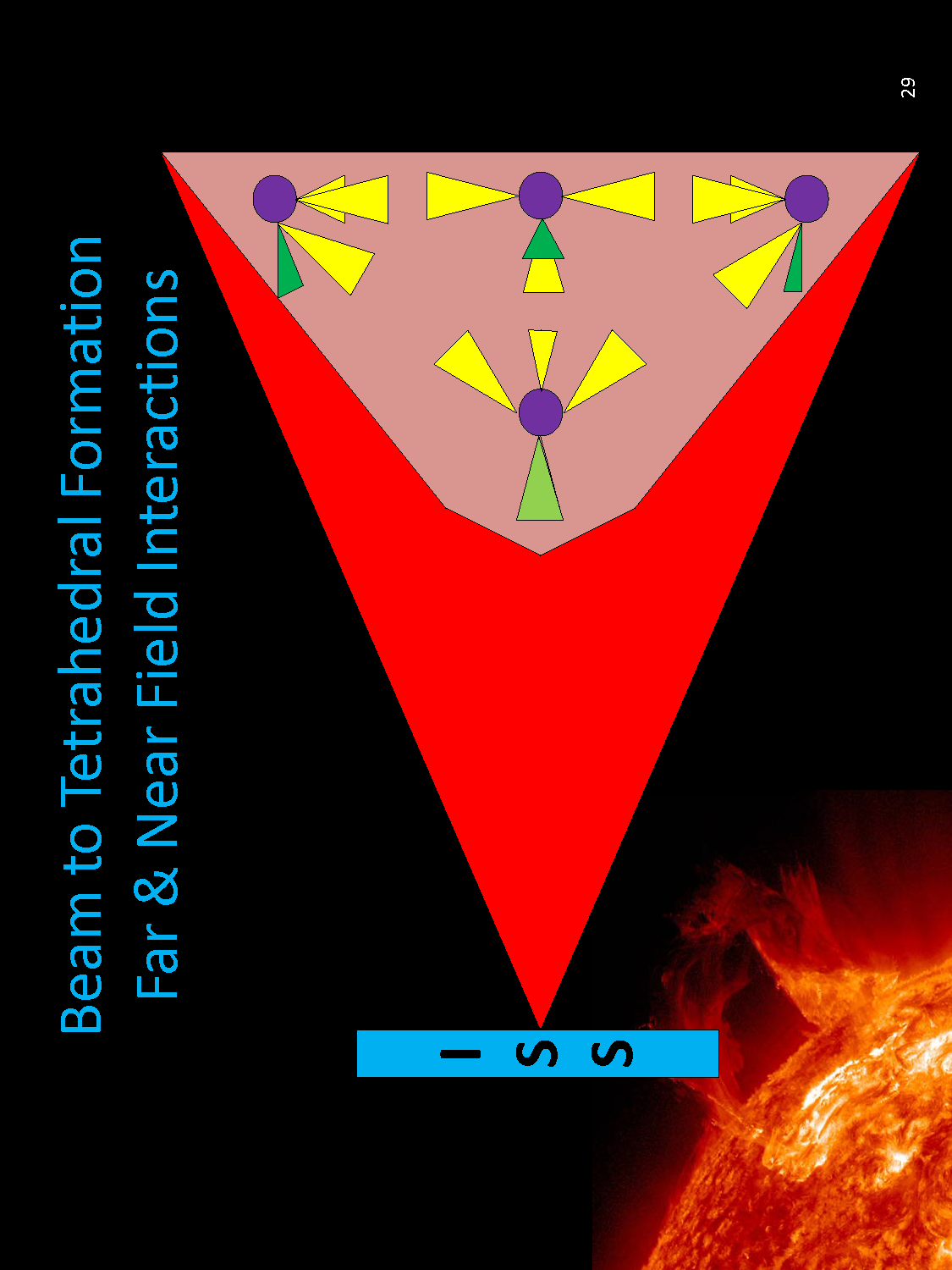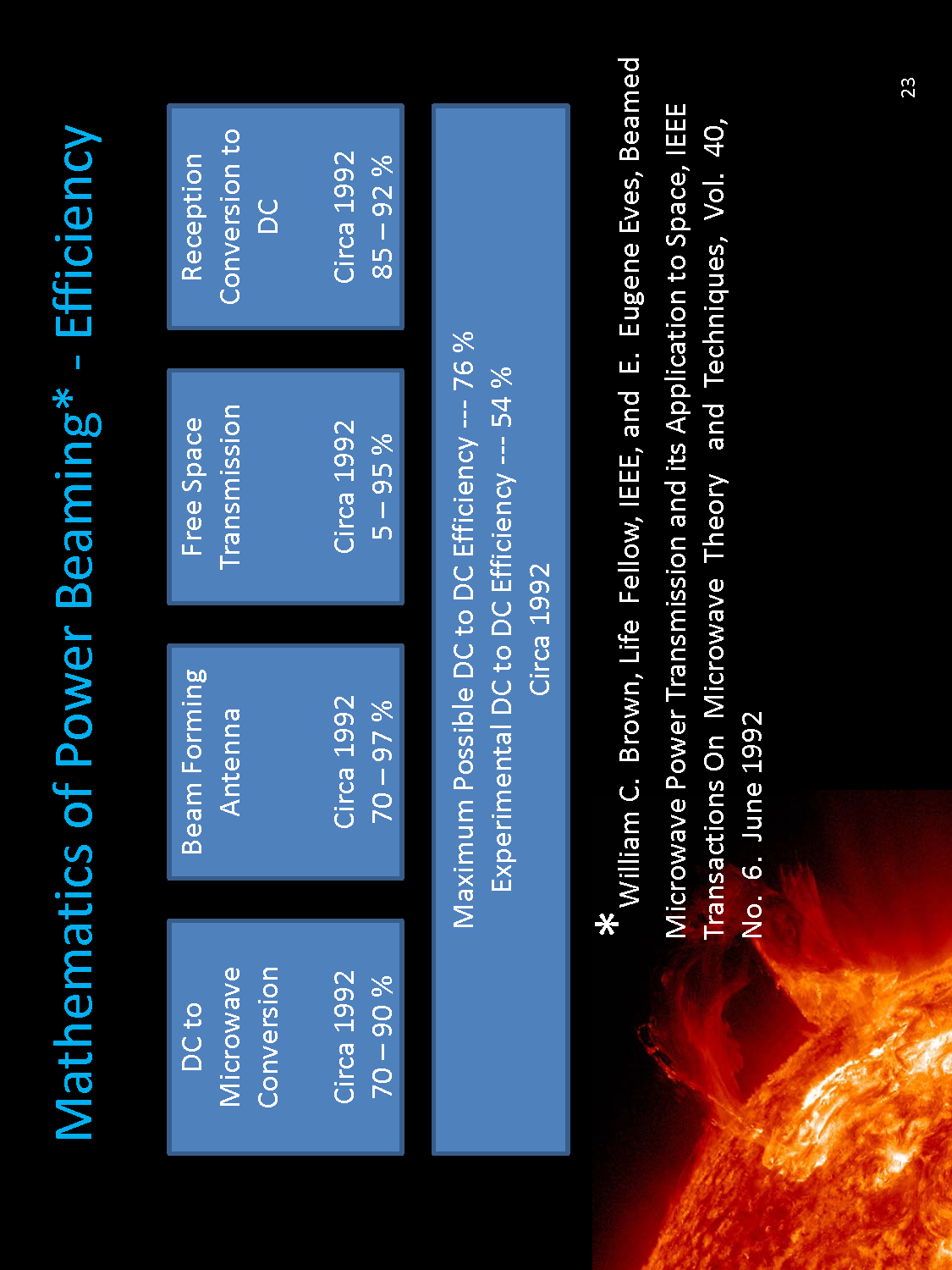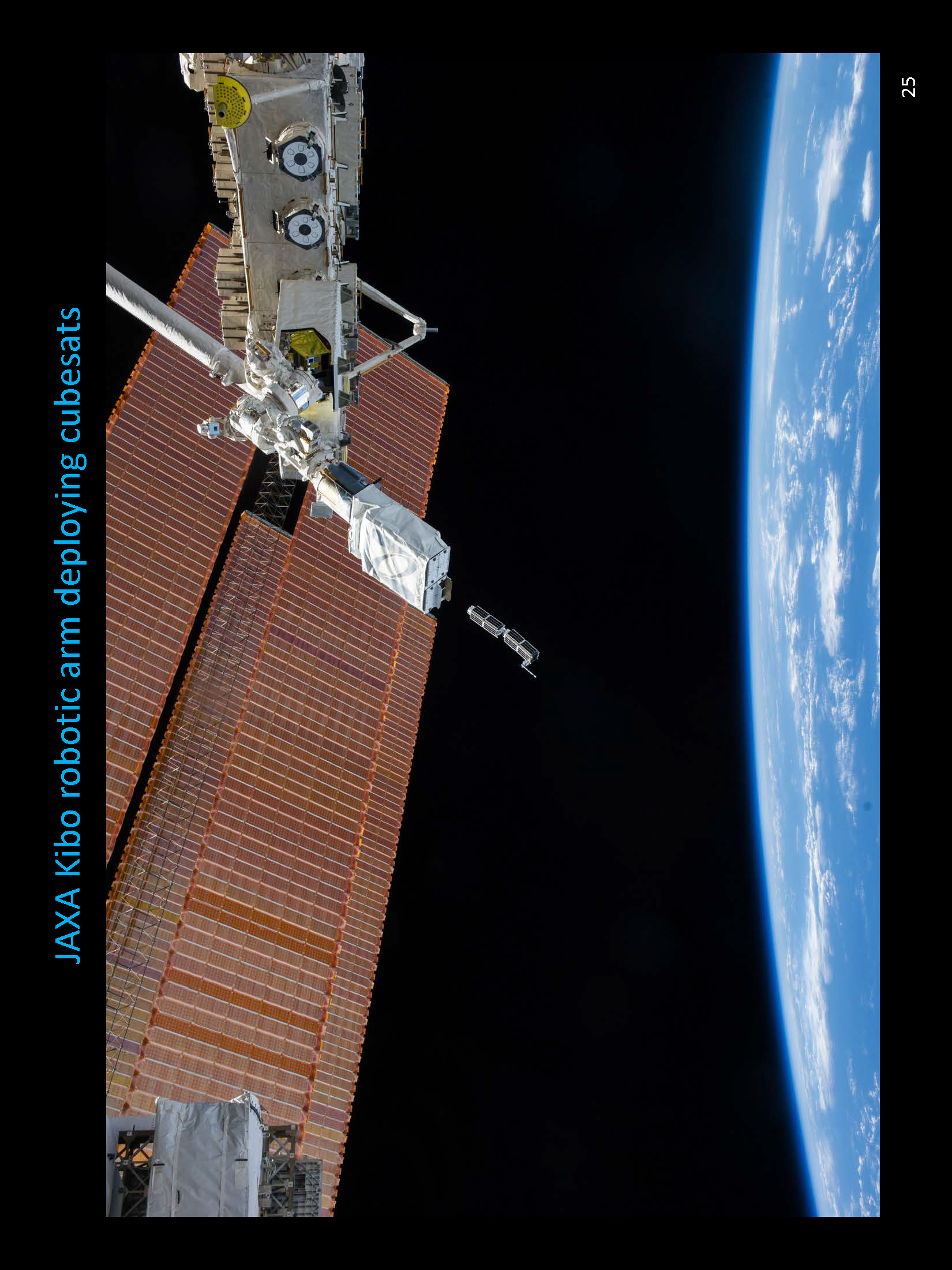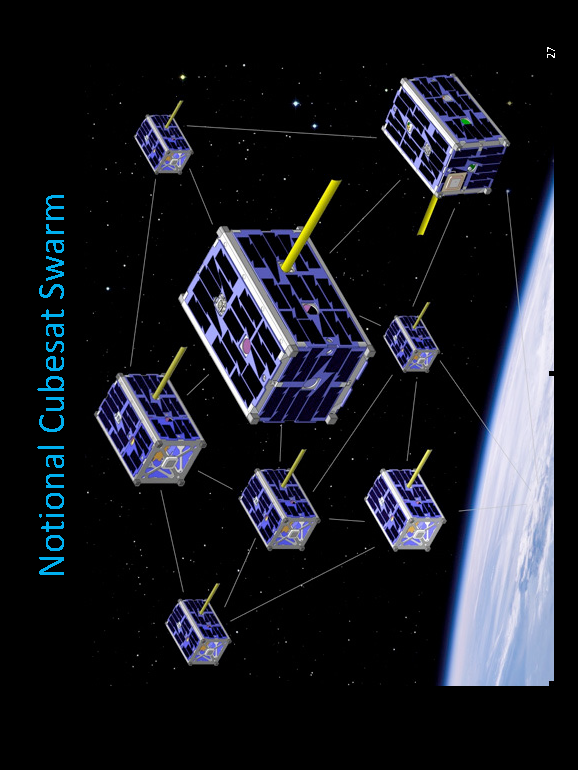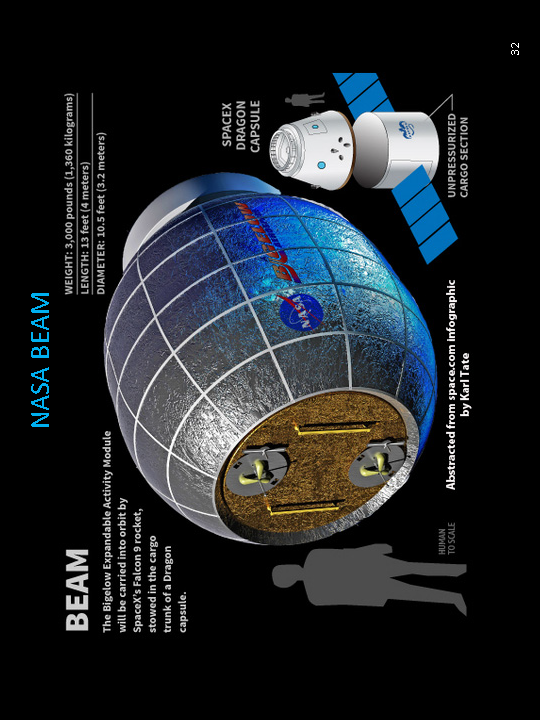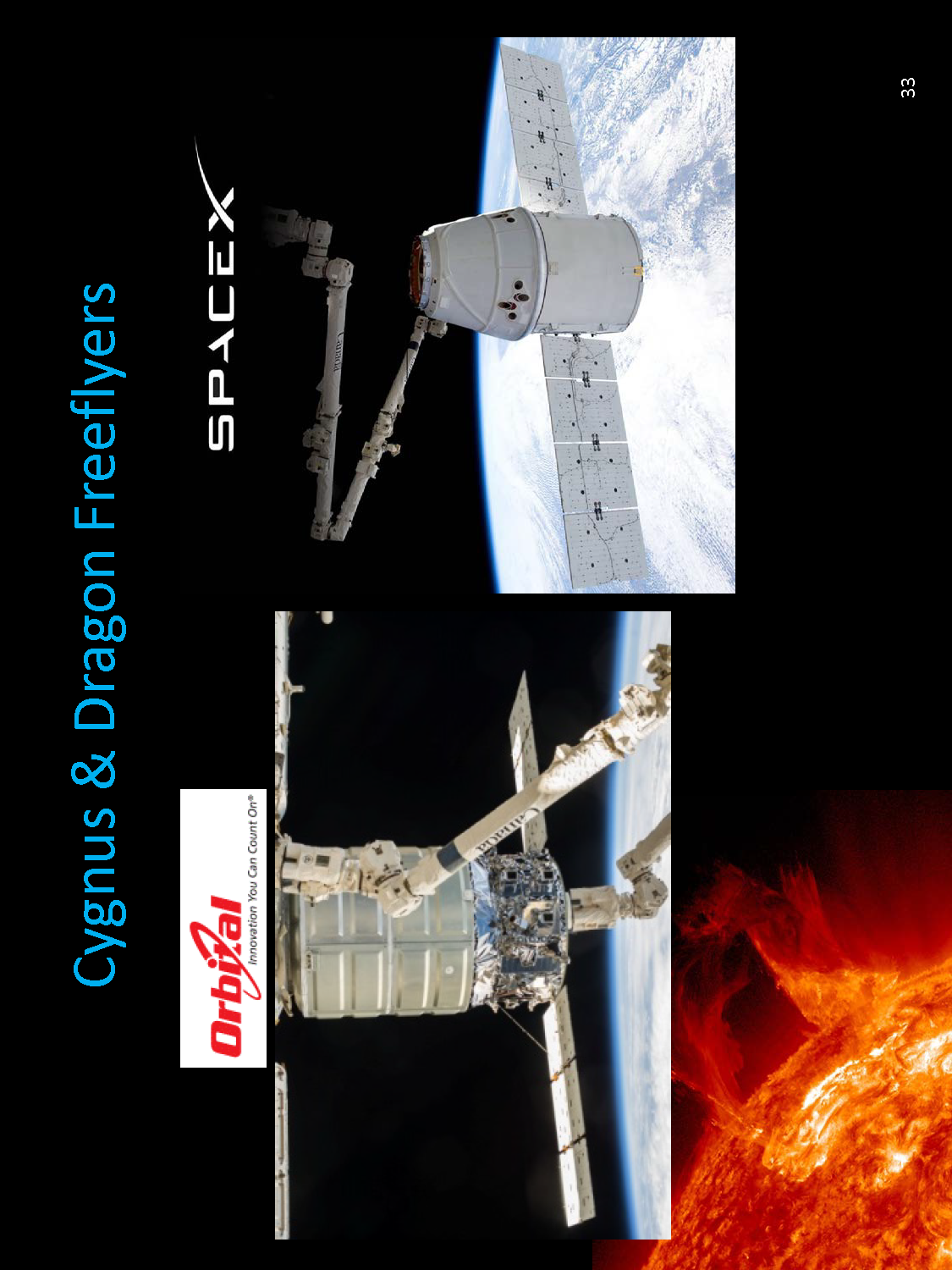User Tools
Table of Contents
XISP-Inc Response to GAME CHANGING DEVELOPMENT PROGRAM INDUSTRY-DEVELOPED POWER BEAMING TECHNOLOGY - REQUEST FOR INFORMATION NNH15ZOA001L
RFI Requirements & Considerations
- The full text of the RFI is referenced here for completeness – GAME CHANGING DEVELOPMENT PROGRAM INDUSTRY-DEVELOPED POWER BEAMING TECHNOLOGY - REQUEST FOR INFORMATION NNH15ZOA001L nnh15zoa001l_rfi_20141208.pdf
- Request for Information Due: January, 31 2015 (5:00pm Eastern)
- Responses are limited to no more than 15 pages and should be uploaded as a single PDF file attachment not to exceed 10MB at the NPIRES web site (http://nspires.nasaprs.com).
- The information provided in response to this RFI will not be disclosed publicly or used outside of the government for any purposes.
RFI Requested Information
The responses to this RFI should include the following information:
Company information:
- Company name:…………………….. Xtraordinary Innovative Space Partnerships, Inc. (XISP-Inc)
- Company address:…………………. 8012 MacArthur Boulevard, Cabin John, MD 20818
- Company point-of-contact name:.. Gary Pearce Barnhard
- Company e-mail address:…………. gary.barnhard@xisp-inc.com Alternate: barnhard@barnhard.com
- Company phone number:…………. +1 301 229 8012
- Company website:………………….. http://www.xisp-inc.com
Feasibility of a partnership:
- Is a NASA-industry cooperation feasible? -
- Yes, NASA-industry cooperation on “industry developed power beaming technology” is not only feasible it can serve as another compelling demonstration of the value of innovative public-private partnerships as means to build new infrastructure which necessitates technology development to accomplish.
- Power beaming applications can be categorized by venue, each of which presents unique requirements, different criteria for functional/operational success, and have different fundamental figures of merit for characterizing the design of effective and efficient systems.
- Space-to-Space applications involve the use of radiant energy beaming between two or more free-flying flight articles not encumbered by atmosphere, separated by a variable distance that can be controlled to some level.
- Space-to-Surface/Surface-to-Space applications involve the use of radiant energy beaming from an orbiting flight system to one or more fixed and/or moving objects on a surface or conversely from a surface to one or more orbiting flight systems. The radiant energy beam may or may not have to pass through significant atmosphere.
- Space-to-Atmospheric/Atmospheric-to-Space & Ground-to-Atmospheric/Atmospheric-to-Ground applications are a special bi-furicated subset of Space-to-Surface/Surface-to-Space applications where the point of delivery varies and/or is used as relay.
- Surface-to-Surface applications involve the use of radiant energy beaming from one fixed installation to one or more fixed and/or moving objects on a surface with or without the presence of a significant atmosphere.
- XISP-Inc's effort is focused on demonstrating space-to-space power beaming in the near term in order to learn practical lessons before larger systems are designed for Space-to-Space or other venues. In addition, there are allied efforts in other venues which will benefit from ongoing collaboration as the technology matures.
What is the problem being addressed?
- XISP-Inc has hypothesized that unbundling power systems (i.e., the separation of power generation, transmission, control, storage, and loads) can:
- reduce spacecraft complexity and thereby reduce cost, schedule, and technical risk
- reduce mass and/or volume required to accomplish a given mission
- reallocate mass and/or volume to enhance or enable missions
- impart additional delta-V along velocity vectors of choice to enhance or enable missions
- foster the development of loosely coupled modular structures to enable:
- formation flying of multiple spacecraft (e.g., interferometric groups, swarms)
- distributed payload and subsystem infrastructure to simplify the accommodation of multiple plug-in and plug-out interfaces
- large scale adaptable space structures that minimize conducted thermal and/or structural loads.
What is the relevance of the problem to the questions posed by this RFI?
- The XISP-Inc has proposed cubesat target demonstrating power beaming from ISS will require the cooperation of several elements of NASA and Industry, but would result in near term demonstration of space-to-space power beaming, and allow rapid iteration of designs and experiments.
- Establishing a functioning ISS power beaming testbed could allow experimentation and validation of components of larger power beaming systems, and reduce the risk of the development of the larger dedicated systems.
- Although the experiments with ISS and cubesats would be small scale, there could be immediate applications for subsatellites near ISS, as well as designs for distributed payloads and sensors for deep space missions.
- A primary mission of XISP is to develop cooperative arrangements with different parts of NASA and different industry partners. The early implementation of a power beam demonstration on ISS, coordinated by XISP, could enhance and enable the demonstration of other power beaming designs that are being proposed in response to this RFI.
What is the proposed solution?
- Space-to-space power beaming is an application of Space Solar Power technology which could:
- be tested/implemented now to immediate benefit
- serve as a means of incrementally maturing the technology base
- A technology development mission proposed for the International Space Station (ISS) which:
- leverages available resources to serve as a testbed
- simultaneously supports payload experiments
- serves to help mitigate perceived cost, schedule, and technical risk associated with the use of Space Solar Power
- The work described has been proposed as part of a draft Space Act Umbrella Agreement Annex under negotiation between NASA and XISP-Inc.
- This experiment is an opportunity to craft viable technology demonstrations that will establish the basis for a confluence of interest between real mission users and the space-to-space power beaming technology development effort.
- This can lead to a range of technology development missions on ISS and subsequent flight opportunities that can make efficient and effective use of beamed energy to support:
- sustained operations,
- directly and/or indirectly augmented propulsion, and
- loosely coupled modular structures.
What are the experiment objectives?
- Demonstrate space-to-space power beaming by powering multiple co-orbiting (~200 m ”stand-off distance”) CubeSat sized (3 to 6 U) spacecraft using an ISS based transmitter.
- It is anticipated that the initial work would begin with Ka-band frequencies and then make use of other frequencies as they become available.
- Demonstrate the successful characterization as well as the scaleable direct and indirect use of radiant energy “beam” components.
- Reduce the cost, schedule, and technical risk associated with the use of the space solar power technology to better address the mission challenges for a new spacecraft and/or infrastructure.
- What type of agreement with NASA is desired by your company and why? -
- A non exclusive “Nonreimbursable Technical Exchange Space Act Umbrella Agreement for Technology Development germane to computer, robotic, and space systems engineering” which allows for the definition of new mission annexes as necessary and appropriate. Furthermore, where deemed advantageous to all parties, said agreement should explicitly allow for the development and execution of lower level agreements that involve the transfer of resources, including funds as necessary and appropriate, to best achieve mission success.
- Identify any particular considerations, circumstances, or issues that would need to be addressed in an agreement.
- For example, what are your expectations regarding the allocation of intellectual property rights?
- Based on NASA & XISP-Inc Nonreimbursable Technical Exchange Space Act Umbrella Agreement Draft 7, October 7, 2014 submitted for NASA review the substantive text additions and/or modifications from standard language/fill-in content are as follows:
- 3. Purpose. The purpose must clearly state and acknowledge the intent of the agreement to foster innovative partnerships.
(Inserted text into base wording is underlined) This Umbrella Agreement (hereinafter referred to as the “Agreement” or “Umbrella Agreement”) shall be for the purpose of facilitating technology development germane to robotic, space, and computer systems engineering deemed of mutual interest to the parties.
The set of missions to be investigated are intended to further explore and develop the intersection of space, robotic, and computer systems engineering as a means to foster the rapid maturation of otherwise stranded intellectual property/nascent technology development work into some combination of commercially viable products as well as mission enhancing and/or mission enabling technology.
The set of missions to be investigated are intended to leverage existing space infrastructure and resources (including but not limited to the International Space Station, the existing Near Earth Network, and the Deep Space Network) and ground infrastructure (supporting testbed research, analysis, and operations). An intrinsic element of the technology development missions to be undertaken is the necessity, driven by the prevailing resource constraints, of fostering communities of interest that cross traditional discipline boundaries from the inception of the work. It is through turning what would otherwise be a competition for resources into an impetus for cooperation that one can best draw out the potential value of the work allowing the greatest potential for applicability to real missions. Accordingly, missions proposed have, are, and will be intentionally designed to cross leverage some combination of intra- and inter-organizational research, development, and commercial interests that could serve all concerned as a fresh entry point yielding demonstrable experience that could be the basis for broader discussion and cooperative work.
The Parties shall execute one (1) or more Annex Agreements (hereinafter referred to as the “Annex”) concurrently with this Umbrella Agreement. The Parties may execute subsequent Annexes under this Umbrella Agreement consistent with the purpose and terms of this Umbrella Agreement. This Umbrella Agreement shall govern all Annexes executed hereunder; no Annex shall amend this Umbrella Agreement. Each Annex will detail the specific purpose of the proposed activity, responsibilities, schedule and milestones, and any personnel, property or facilities to be utilized under the task. This Umbrella Agreement takes precedence over any Annexes. In the event of a conflict between the Umbrella Agreement and any Annex concerning the meaning of its provisions, and the rights, obligations and remedies of the Parties, the Umbrella Agreement is controlling.
- Responsibilities. The NASA and Partner responsibilities must be clearly stated.
NASA will: 1. Provide support of projects undertaken in any Annex; 2. Provide Partner State participant(s) and internal coordination of approvals for Annexes; 3. Provide for a single point of contact for Annex development, coordination, and operations.
Partner will: 1. Provide support of projects undertaken in any Annex; 2. Provide non-Partner State participant(s) and internal coordination of approvals for Annexes; 3. Provide for a single point of contact for Annex development, coordination, and operations. 4. Provide notification to NASA of all substantive non-NASA participant(s) actions germane to each Annex on an ongoing basis.
- Financial Obligations. The financial obligations clause should not preclude and should explicitly allow for lower level agreements that may involve the transfer of resources, including funding.
There will be no transfer of funds between the Parties under this Agreement and each Party will fund its own participation. This clause in no way shall be deemed to preclude direct or indirect funding participation of NASA to XISP-Inc or other involved entities supporting related work based on other agreements and/or subagreements. All activities under or pursuant to this Agreement are subject to the availability of funds, and no provision of this Agreement shall be interpreted to require obligation or payment of funds in violation of the Anti-Deficiency Act, (31 U.S.C. § 1341).
- Insurance. Standard general liability business insurance and professional liability insurance requirements must be realistically allocated.
Conventional insurance coverage has been determined to be unavailable based on the scope of the Umbrella agreement, specific insurance requirements not borne or waived by NASA will be addressed in each Annex and/or subagreement as applicable.
- Intellectual Property. All intellectual property rights not explicitly held by others, waived, cross-licensed, or otherwise delegated by mutual consent shall be retained by the developing party (NASA, XISP-Inc, or in some cases rights may be retained by an XISP-Inc teammate). All required work to prevent clouded title to IP including any cross-licensing and/or use permits required for mission implementation will be supported by all parties in an amicable and timely manner to allow mission execution to proceed.
Potential industry contributions:
- List potential industry contributions that would complement the possible NASA contributions outlined above.
- Technical Expertise
- Mission Requirements
- Prior flight program experience
- Prior research experience
- Test Facilities
- Ground Test
- Atmospheric Test
- Flight Test
- Hardware & Software
- ground test articles
- flight system components
- Cygnus Commercial Cargo Carrier - Frank Culbertson
- Dragon Commercial Cargo Carrier - Gwen Shotwell
- ATV Cargo Carrier follow-on - ESA
- HTV Cargo Carrier follow-on - JAXA
- Progress Cargo Carrier - ROSCOSMOS
- Service customers
Potential NASA contributions:
- What expertise and support (including both labor and facilities) does your company need from NASA?
- Technical Expertise
- Mission Requirements
- Prior flight program experience
- Prior research experience
- Test Facilities
- Ground Test
- Atmospheric Test
- Flight Test
- Interoperating Vehicles
- International Space Station (ISS)
- Other flight systems
- Hardware & Software
- ground test articles
- flight system components
- external ISS attachment locations
Services concept:
- What commercial activities do you plan to offer if the partnership is successful?
- We wish to offer a cornucopia of services using all components of available radiant beams (i.e., power, data, force, and heat).
- Describe the proposed activity, the equipment required to conduct it, and the role power beaming would play in the concept.
- The first principles physics of both near field and far field energy effects are considered well understood. However, the use of radiant energy (by definition a Far field effect, a.k.a. “Beaming”) to transfer (power, data, force, heat) either directly and/or by inducing near field effects at a distance is less understood at least from the stand point of practical applications.
- To optimize beaming applications we need to better understand how each of the components of radiant energy can be made to interact in a controlled manner.
- Radiant energy components include:
- Electrical
- Magnetic
- Linear & Angular Momentum
- Thermal
- Data
- There are direct and indirect uses for each component of a radiant energy beam.
- Use of any combination of these components has implications for all spacecraft systems (e.g., power, data, thermal, communications, navigation, structures, GN&C, propulsion, payloads, etc.)
- In theory, the use of the component interactions can enable:
- Individual knowledge of position and orientation
- Shared knowledge
- loose coupling /interfaces between related objects
- Near network control (size to sense/proportionality to enable desired control)
- Fixed and/or rotating planar beam projections
- Generating net outward velocity “push”
- Generating net inward velocity “pull”
- Generating net velocity along any specified vector
- The estimated power density at 200 m (the outer boundary of the ISS Keep Out Sphere measured from the center of mass) is a function of the diameter of the transmitting antenna, the power output of the transmitter, and the transmission frequency.
- Assuming 45.72 cm diameter transmitter antenna, 40 Watts transmitter power, and a transmission frequency of 26.5 GHz estimated power density at 200 m (the outer boundary of the ISS Keep Out Sphere measured from the center of mass) for the non-optimized system is 0.00015904 Watts/cm*cm.
- Use of any combination of larger diameter transmitter antennas, higher transmitter power, and higher transmission frequencies increases the power density for a given distance.
What are the flight test vehicles?
- The initial flight test vehicles are anticipated to be CubeSat sized between 3U to 6U, including the collapsed rectenna.
- Deep Space Industries, Inc. will supply the initial flight test articles, except for the rectennas out of its existing agile nanosatellite platform development program.
- It is anticipated the XISP-Inc will build/buy the custom rectennas required for the initial flight test articles.
- Subsequent 1U to 6U test articles will be sourced on a cooperative basis with interested commercial, university, governmental, non-governmental organization, and potentially international concerns.
What are the capabilities of the initial flight test articles?
- The initial flight test articles are anticipated to consist of a set of subsystems built to existing CubeSat standard interfaces:
- A 3U CubeSat structural frame with flight heritage designed for passive thermal control.
- An electrical power subsystem that includes a micro-grid controller capable of handling solar array, battery, and rectenna power sources:
- Battery Pack
- Solar Arrays (deployable and body mounted)
- Rectenna (deployable and body mounted)
- A general purpose on-board computer.
- An Attitude Determination and Control Subsystem (ADCS) / Guidance, Navigation and Control (GNC) subsystem including:
- Sun Sensors
- Reaction Wheels & Controller for orbital maintenance and station keeping
- Magnetometer for 3-axis stability control
- A payload subsystem reserve which will be customized and/or reallocated to meet the experiment needs.
- A communication subsystem:
- UHF/VHF, S, Ku, and/or Ka Band antenna arrays as needed
- Cooperative use of the rectenna is anticipated where possible
- UHF/VHF, S, Ku, and/or Ka Band transmitters as needed
- Cooperative use of the rectenna is anticipated where possible
- A combination of both open-loop and closed-loop pointing strategies will be used as needed
- A tracking, telemetry, and command subsystem
- A propulsion subsystem using non-toxic cold gas with flight heritage capable of active positioning and end-of-life disposal as needed.
What are the characteristics of the receiving antenna (rectenna)?
- Current plans call for the rectenna to have up to 1 square meter of surface area.
- Based on the anticipated power density to meet the minimum customer test requirement of 1+ Watts of delivered power at 200m from the ISS center of mass the approximate rectenna sized required is as follows:
- At 26.5 GHz with a 40 W transmitter and a 45.72 cm diameter antenna at least .75 square meters of receiving antenna surface area is required
- At 36 GHz with a 1000 W transmitter and a 100 cm diameter antenna at least 32.5 square centimeters of receiving antenna surface area is required
- At 95 GHz with a 1000 W transmitter and a 100 cm diameter antenna at least 4.57 square centimeters of receiving antenna surface area is required
- This power level is anticipated to be sufficient for nominal flight test article operations.
- Active station keeping mode will require use of stored power as well as solar arrays and/or rectenna as appropriate.
How will the flight test articles be launched?
- The flight test articles will designed for launch as either pressurized or unpressurized cargo on the first available up-mass opportunity after satisfactory completion of the flight safety review.
- Pressurized cargo would exit the pressurized volume via the Japanese Exploration Agency (JAXA) Kibo Exposed Facility airlock and be handed off by the JAXA Kibo robotic large arm to the Mobile Servicing Centre (MSC), which includes the Mobile Base Structure, Space Station Remote Manipulator System, and Special Purpose Dexterous Manipulator.
- Unpressurized cargo would be unloaded using the MSC and stowed externally prior to deployment.
How will the flight test articles be deployed?
- It is anticipated that the flight test articles will be deployed using the Mobile Servicing Centre, most likely relying on Dextre (a.k.a. the Special Purpose Dexterous Manipulator).
- Deployment will optimized to make use of the best available release mechanisms anticipated to be on-orbit at the time required.
- The MSC will be parked in a location that allows the best alignment between the transmitting antenna pointing vector and the deployment release vector.
- It is anticipated that release would be in the RAM (forward) – Starboard (right) direction inclined towards Zenith optimized to facilitate pointing by the available transmitter.
What is the anticipated co-orbiting dwell time of the initial flight test articles?
- It is anticipated that initial flight test articles will co-orbit with ISS just outside of the Keep Out Sphere until the end-of-life propulsion reserve limit is reached.
- The anticipated dwell time of the initial flight test articles in the beam will be constrained by the efficiency of the flight article ACDS/GNC and Propulsion subsystems, the ISS reboost schedule, as well as the availability and pointing accuracy of the transmitter antenna subsystems.
What is the anticipated schedule?
- New mission approval has been requested for 1st Quarter FY2015
- Initial flight test article subsystem availability for mixed mode testing is anticipated as early as 3rd Quarter FY2015
- Completed flight test article availability for testing as early as 4th Quarter FY2015
- Initial ISS testing 1st Quarter FY2016, subject to the successful completion of the flight safety reviews and availability of up-mass scheduling
How did you calculate the anticipated Power Density and Power Received?
- XISP-Inc working notes on Power Beaming calculations were last updated October 21, 2014. Calculations have been peer reviewed and found consistent with the relevant papers in the field and profession practice.
- Transmitter power is provided by the ISS power system
- William C. Brown, Life Fellow, IEEE, and E. Eugene Eves, Beamed Microwave Power Transmission and its Application to Space, IEEE Transactions On Microwave Theory and Techniques, Vol. 40, No. 6. June 1992
- Pd power density at the center of the receiving location
- Pi total radiated power from the transmitter
- Ai total area of the transmitting antenna
- λ wavelength
- D separation between the transmitting and receiving apertures
- Pd = (Ai)*(Pi)/(λ2)*(D2)
In theory, there is no difference between theory and practice – but in practice, there is.
– Jan L.A. van de Snepscheut
computer scientist
- The proposed NASA XISP-Inc Space Act Umbrella Agreement Space-to-Space Power Beaming Annex is being used to garner support for moving forward with mission definition and development.
- Partners/participants are being sought in the commercial, academic, non-profit, and government sectors.
- Use of ISS helps ensure that this is an international cooperative/collaborative research effort.
Technology Readiness Level:
- What is the Technology Readiness Level (TRL) of the technology described in the RFI response?
- TRL 1 - Achieved
- Brown, William C. Life Fellow, IEEE, and Eves, E. Eugene, Beamed Microwave Power Transmission and its Application to Space, IEEE Transactions On Microwave Theory and Techniques, Vol. 40, No. 6. June 1992
- Andreev, Andrey D. Notes on NASA's Assessments on Laser and Millimeter-wave Power Beaming Technologies, Raytheon Missile Systems 2012
- TRL 2 - Achieved
- Barnhard, Gary Pearce, presentation, Is there a business case for space based solar power for terrestrial applications? Presentation to Advanced Technology Working Group (ATWG) December 2009, Mountain View, CA
- Barnhard, Gary Pearce, presentation, Debating the Point: A Recent Discussion on the Topic of Space Solar Power. Presentation 1st NSS Space Solar Power Symposium, International Space Development Conference (ISDC 2010)Chicago, IL (May 2010)
- Barnhard, Gary Pearce Review Presentation/Review Panelist, Mission Development Forum, International Space Development Conference (ISDC 2011) Huntsville, AL (May 2011)
- Barnhard, Gary Pearce Review Presentation/Panelist, Turning good ideas into gold - blazing a trail through the technology development valley of death Presentation/Panel, International Space Development Conference (ISDC 2012) Washington, DC (May 2012)
- Barnhard, Gary Pearce, presentation, Suspending Disbelief - Unbundling Space Power Systems to foster applications of Space-to-Space Power Beaming, International Space Development Conference (ISDC 2013), San Diego, CA May 25, 2013
- Barnhard, Gary Pearce, poster session, Space-to-Space/Surface Power Beaming, AAS / NASA / CASIS 2nd Space Station Users Conference, Denver, CO July 16, 2013
- Barnhard, Gary Pearce, presentation, Suspending Disbelief - Unbundling Space Power Systems to foster applications of Space-to-Space Power Beaming Presentation to NASA Future In-Space Operations (FISO) Colloquia (October 30, 2013)
- Barnhard, Gary Pearce, presentation, Suspending Disbelief - Unbundling Space Power Systems to foster applications of Space-to-Space Power Beaming, IEEE International Conference on Wireless for Space and Extreme Environments (WiSEE) Space Based Solar Power Workshop, Baltimore, MD November 8, 2013
- Barnhard, Gary Pearce Associate Fellow, AIAA, presentation, Space-to-Space Beamed Power, Space Solar Power (SSP 2014) Kobe, Japan April 15, 2014
- Barnhard, Gary Pearce, presentation, Space-to-Space Beamed Power, International Space Development Conference (ISDC) 2014, Los Angeles, CA May 15, 2014
- Barnhard, Gary Pearce, poster presentation, Suspending Disbelief - Unbundling Space Power Systems to foster applications of Space-to-Space Power Beaming AAS/NASA/CASIS 3rd Annual ISS Research and Development Conference Chicago, IL (July 2014)
- Barnhard, Gary Pearce, Unbundling Space Power Systems to foster applications of Space-to-Space Power Beaming, presentation & paper (IAC-14-C3.1.9) International Astronautical Congress IAC 2014 Toronto, Canada
- Mankins, John C., The Case for Space Solar Power, Virginia Edition Publishing, 2014
- TRL 3 - Achieved In Part, XISP-Inc Proposes to Complete
- Jaffe, P.; Hodkin, J.; Harrington, F., “Development of a sandwich module prototype for Space Solar Power,” Aerospace Conference, 2012 IEEE , vol., no., pp.1,9, 3-10 March 2012 doi: 10.1109/AERO.2012.6187077
- TRL 4 - XISP-Inc Proposes to Complete
- TRL 5 - XISP-Inc Proposes to Complete
- TRL 6 - XISP-Inc Proposes to Complete
- TRL 7 - XISP-Inc Proposes to Complete
- TRL 8 - XISP-Inc Proposes to Complete
- TRL 9 - XISP-Inc Proposes to Complete
NASA Fiscal Year 2015 SBIR/STTR Appendix A: Technology Readiness Level (TRL) Descriptions
The Technology Readiness Level (TRL) describes the stage of maturity in the development process from observation of basic principles through final product operation. The exit criteria for each level documents that principles, concepts, applications or performance have been satisfactorily demonstrated in the appropriate environment required for that level. A relevant environment is a subset of the operational environment that is expected to have a dominant impact on operational performance. Thus, reduced-gravity may be only one of the operational environments in which the technology must be demonstrated or validated in order to advance to the next TRL.
| TRL | Definition | Hardware Description | Software Description | Exit Criteria |
|---|---|---|---|---|
| 1 | Basic principles observed and reported. | Scientific knowledge generated underpinning hardware technology concepts/applications. | Scientific knowledge generated underpinning basic properties of software architecture and mathematical formulation. | Peer reviewed publication of research underlying the proposed concept/application. |
| 2 | Technology concept and/or application formulated. | Invention begins, practical application is identified but is speculative, no experimental proof or detailed analysis is available to support the conjecture. | Practical application is identified but is speculative, no experimental proof or detailed analysis is available to support the conjecture. Basic properties of algorithms, representations and concepts defined. Basic principles coded. Experiments performed with synthetic data. | Documented description of the application/concept that addresses feasibility and benefit. |
| 3 | Analytical and experimental critical function and/or characteristic proof of concept. | Analytical studies place the technology in an appropriate context and laboratory demonstrations, modeling and simulation validate analytical prediction. | Development of limited functionality to validate critical properties and predictions using non-integrated software components. | Documented analytical/experi-mental results validating predictions of key parameters. |
| 4 | Component and/or breadboard validation in laboratory environment. | A low fidelity system/component breadboard is built and operated to demonstrate basic functionality and critical test environments, and associated performance predictions are defined relative to the final operating environment. | Key, functionally critical, software components are integrated, and functionally validated, to establish interoperability and begin architecture development. Relevant Environments defined and performance in this environment predicted. Documented test performance demonstrating agreement with analytical predictions. | Documented definition of relevant environment. |
| 5 | Component and/or breadboard validation in relevant environment. | A medium fidelity system/component brassboard is built and operated to demonstrate overall performance in a simulated operational environment with realistic support elements that demonstrates overall performance in critical areas. Performance predictions are made for subsequent development phases. | End-to-end software elements implemented and interfaced with existing systems/simulations conforming to target environment. End-to-end software system, tested in relevant environment, meeting predicted performance. Operational environment performance predicted. Prototype implementations developed. | Documented test performance demonstrating agreement with analytical predictions. Documented definition of scaling requirements. |
| 6 | System/sub-system model or prototype demonstration in a relevant environment. | A high fidelity system/component prototype that adequately addresses all critical scaling issues is built and operated in a relevant environment to demonstrate operations under critical environmental conditions. | Prototype implementations of the software demonstrated on full-scale realistic problems. Partially integrate with existing hardware/software systems. Limited documentation available. Engineering feasibility fully demonstrated. | Documented test performance demonstrating agreement with analytical predictions. |
| 7 | System prototype demonstration in an operational environment. | A high fidelity engineering unit that adequately addresses all critical scaling issues is built and operated in a relevant environment to demonstrate performance in the actual operational environment and platform (ground, airborne, or space). | Prototype software exists having all key functionality available for demonstration and test. Well integrated with operational hardware/software systems demonstrating operational feasibility. Most software bugs removed. Limited documentation available. | Documented test performance demonstrating agreement with analytical predictions. |
| 8 | Actual system completed and “flight qualified” through test and demonstration. | The final product in its final configuration is successfully demonstrated through test and analysis for its intended operational environment and platform (ground, airborne, or space). | All software has been thoroughly debugged and fully integrated with all operational hardware and software systems. All user documentation, training documentation, and maintenance documentation completed. All functionality successfully demonstrated in simulated operational scenarios. Verification and Validation (V&V) completed. | Documented test performance verifying analytical predictions. |
| 9 | Actual system flight proven through successful mission operations. | The final product is successfully operated in an actual mission. | All software has been thoroughly debugged and fully integrated with all operational hardware/software systems. All documentation has been completed. Sustaining software engineering support is in place. System has been successfully operated in the operational environment. | Documented mission operational results. |
Business model:
- Does your intended business strategy offer commercial services or is it to conduct exploration and prospecting for your own purposes?
- Strategy is to deliver something of demonstrable commercial value for each increment of resources invested.
- The first set of products is data in context (a.k.a. information) regarding unbundled power system performance.
- The second set of products is information in perspective (a.k.a. knowledge) about how to optimize an unbundled power system to best meet mission requirements.
- The third set of products are follow-on products; some combination of technology licenses, saleable system components, and/or saleable services.
- Have you identified potential customers or developed business plans around your envisioned activities?
- Product 1 Information on the efficiency and effectiveness of space-to-space power beaming
- Product 2 Knowledge of how to optimize and unbundled power system - Deep Space Industries, Inc.
- Product 3 Technology licenses, saleable system components, and/or saleable services
- XISP-Inc has been actively working with the following communities and organizations to further mission development and build a extraordinary mission implementation team (NOTE: Our team includes more than members of the space community. It reflects our interdisplinary global partnerships):
- Xtraordinary Innovative Space Partnerships, Inc. (XISP-Inc) - Gary Barnhard, et.al. (Mission Lead + rectenna supplier)
- Deep Space Industries, Inc. (DSI) - Daniel Faber, et.al. (Initial Flight Test Articles)
- Barnhard Associates, LLC (BALLC/XISP,net) - Gary Barnhard, et.al. Information Technology & Services
- National Aeronautics and Space Administration (NASA)
- HQ Space Communications and Navigation Program Office - Jim Schier, et.al.
- HQ Advanced Exploration Systems Division - Jason Crusan, et.al.
- HQ Science Mission Directorate – CASIS Interface, et.al.
- HQ Office of Chief Technologist – Informal briefing with David Miller, et.al. formal briefing pending
- HQ Space Technology Mission Directorate – Formal briefing opportunity requested through channels (TBD)
- HQ ISS Program Office – Sam Scimemi, et.al.
- ARC Mission Control Technologies Laboratory - Jim Trimble, et.al. [Pursuit approved. Space Act Agreement pending]
- GRC Power and In-Space Propulsion Division - Michael Piszczor, et.al. [Power & Cubesat Technical Resource]
- JSC Automation and Robotics - Phil Callen, et.al. [Cubesat Deployment via MSC]
- JSC ISS Project Office Code OZ - Bob Nelson, et.al. [Integration Coordination].
- Naval Research Laboratory - Paul Jaffe, et.al. – rectenna design consultation and testing.
- Other Federal Agencies - including: US Department of Energy, US Environmental Protection Agency, and Federal Emergency Management Agency.
- Center for the Advancement of Science in Space (CASIS) - Justin Kugler, et.al. – unsolicited proposals in funding prioritization review awaiting NASA confirmation of support.
- University Partner Candidates with formal Letters of Interest on file or in work (Grow the community of researchers, and access additional flight test articles).
- University of New Mexico Configurable Space Microsystems Innovations and Applications Center (COSMIAC) - Christos Christodoulou, et.al. – Under Graduate/Graduate Student Researchers, alternate source for flight test articles.
- University of Maryland Space Systems Lab (SSL) - David Akin, et.al. – Under Graduate/Graduate Student Researchers, alternate source for flight test articles.
- Saint Louis University - Michael Swartwout, et.al. – Under Graduate/Graduate Student Researchers, alternate source for flight test articles.
- University of North Dakota - Sima Noghanian/Corey Bergsrud , et.al – Under Graduate/Graduate Student Researchers, alternate source for flight test articles.
- Commercial Partner/Vendor Candidates that have indicated at a minimum that they are willing to examine the opportunities for cooperation/collaboration (leverage flight experience, access alternate flight test articles, testable requirements, and/or funding).
- Zero Gravity Solutions, Inc. - Richard Godwin, et.al. – flight system processing experience.
- Nanoracks, Inc. - Jeffrey Manber/Richard Pournelle, et.al. – flight system processing experience / alternate deployment services.
- Made In Space, Inc. - Michael Snyder, et.al. – flight system processing experience, on orbit printing of parts.
- Orbital Sciences Corporation - Frank Culbertson, et.al. – Cygnus Commercial Cargo Carrier
- ATK Aerospace Group - Jim Armor, et.al. – resource in satellite servicing tool kit
- SPACEX - Gwynne Shotwell, et.al. – Dragon Commercial Cargo Carrier
- Raytheon - Andrey Andreev, et.al. - millimeter-wavelength magnetrons
- Non-Governmental Organization Partners – testable requirements and crowd funding
- National Space Society - David Dunlop, et.al. – educational outreach, community development, national/international collaborative opportunities, wielding the technology to further opportunities for space development.
- International Partners (leverage flight experience, access alternate flight test articles, testable requirements, and funding).
- TBD, after mission approval in coordination with NASA the opportunities for international cooperation will be considered.
- What are the concepts for which power beaming is more cost effective than the generation of power in situ (or transmission using traditional means)?
- It is hypothesized that unbundling power systems (i.e., the separation of power generation, transmission, control, and loads) can result in:
- a reduction of spacecraft complexity,
- a reduction/reallocation of mass and/or volume,
- impart delta-V along velocity vectors of choice, and
- foster the development of loosely coupled modular structures / distributed infrastructure.
- How firm is the demand for products or service stemming from this capability?
- If the cost, schedule, and technical risk can be made tractable there are a myriad of opportunities for application either as mission enhancing and/or mission enabling.
- What revenue model and pricing strategy have you established?
- Strategic investment in mission development.
- Access to information and knowledge generated will be managed to create the demand (i.e., grow the IP commons) and satisfy the demand by some combination of goods and services (i.e., technology licenses, saleable system components, and/or saleable services).
- How stable is your anticipated income stream?
- XISP-Inc has identified multiple sustainable income streams drawn from the Business Cornucopia (see below) that in aggregate can support company operations, mission development work, and pursuit of all available opportunities for mission implementation resources including funding acceleration hold sufficient.
Business Cornucopia
- All missions will be defined as scaleable from the start allowing mission objectives to be met with a minimum funding profile with additional work cycles and enhanced work products added as resources permit. All available funding opportunities are being explored both within NASA, CASIS, commercial concerns, and other agencies with sustaining funding being provided by XISP-Inc partners.
- The XISP-Inc “Follow-the-resources” model of mission development allows for multiple funding and in-kind contributions to support mission development and execution (Attached).
- As an exercise in due diligence, fiscal prudence, and practical economics, XISP-Inc is committed to considering all available options for monetizing the work accomplished to support the ongoing operations, mission development, and mission implementation work of the company.
- PAY for IP:
- Purchase IP
- IP Use License
- IP Cross License
- PAY to PLAY:
- Crowd Sourcing
- Initial public offering (IPO)
- Fees
- PAY to TEST:
- Pay for testbed use
- PAY for DATA & LESSONS LEARNED:
- Pay for experiment data delivered
- Pay for data analysis
- PAY for PARTS:
- Hardware Developed
- Software Developed
- PAY for EXPERTISE:
- Consulting
- PAY for MINDSHARE:
- Marketing & Brand Awareness
- PAY for UTILITIES:
- Electrical Power
- Other
- PAY for COST, SCHEDULE, and/or TECHNICAL RISK REDUCTION:
- Contracted engineering services
- PAY for PARTNERSHIP DEVELOPMENT:
- Mission team building
- PAY for COLLABORATIVE ADVANCED DEVELOPMENT SERVICES:
- Speculative engineering services
- PAY for ALLIED SERVICES:
- Internet Services
- Logistics
- Facilities

